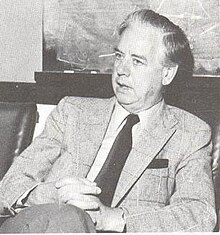Torsten Hägerstrand
| Torsten Hägerstrand | |
|---|---|

Hägerstrand in 1991
|
|
| Born |
October 11, 1916 Moheda, Sweden |
| Died | May 4, 2004 (aged 87) Lund, Sweden |
| Residence | Sweden |
| Citizenship | Sweden |
| Nationality | Swedish |
| Fields | Geography |
| Institutions | Lund University |
| Alma mater | Lund University |
| Known for |
Time geography Human migration Cultural diffusion |
| Notable awards |
Lauréat Prix International de Géographie Vautrin Lud Outstanding Achievement Award from the Association of American Geographers |
Torsten Hägerstrand (October 11, 1916, Moheda – May 3, 2004, Lund) was a Swedish geographer. He is known for his work on migration, cultural diffusion and time geography.
A native and resident of Sweden, Hägerstrand was a professor (later professor emeritus) of geography at Lund University, where he received his doctorate in 1953. His doctoral research was on cultural diffusion. His research has helped to make Sweden, and particularly Lund, a major center of innovative work in cultural geography. He also influenced the practice of spatial planning in Sweden through his students.
Hägerstrand's father was a teacher at a remote elementary school and the family lived at the school. Hägerstrand recalled that his early education was based on the pedagogical ideas of Swiss educator Johann Pestalozzi. Several of Hägerstrand's students speculated that his holistic and visionary thinking was rooted in his early education:
He was taught local geography, history and folklore at home in the Pestalozzi tradition which was being introduced at that time. Cartography, geology, botany and agronomy were all interrelated parts of a more holistic understanding of processes within a spatial area. To start with, children learned about their immediate environment (e.g., the school room and the farm), then about the village, and gradually the whole district. As a pupil of Hägerstrand, it is easy for me to recognize parts of this tradition which later became what we today would refer to as an 'integrative perspective'.
Hägerstrand entered Lund University in 1937. His 1953 doctoral thesis Innovation Diffusion as a Spatial Process gained fame for its innovative use of Monte Carlo simulation of demographic development. It showed how dynamic, incremental simulation of spatial processes could be used at the spatial scale of the individual as well as large spatial aggregates. Forty years later, geographer Andrew Cliff remarked on the foresight of Hägerstrand's methodology: "Bearing in mind that much of the research upon which the book is based dates from a time when computers were almost nonexistent, let alone used by geographers, it is remarkable that the simulation methodology which is so critically dependent upon computing power should have been contemplated."
...
Wikipedia
